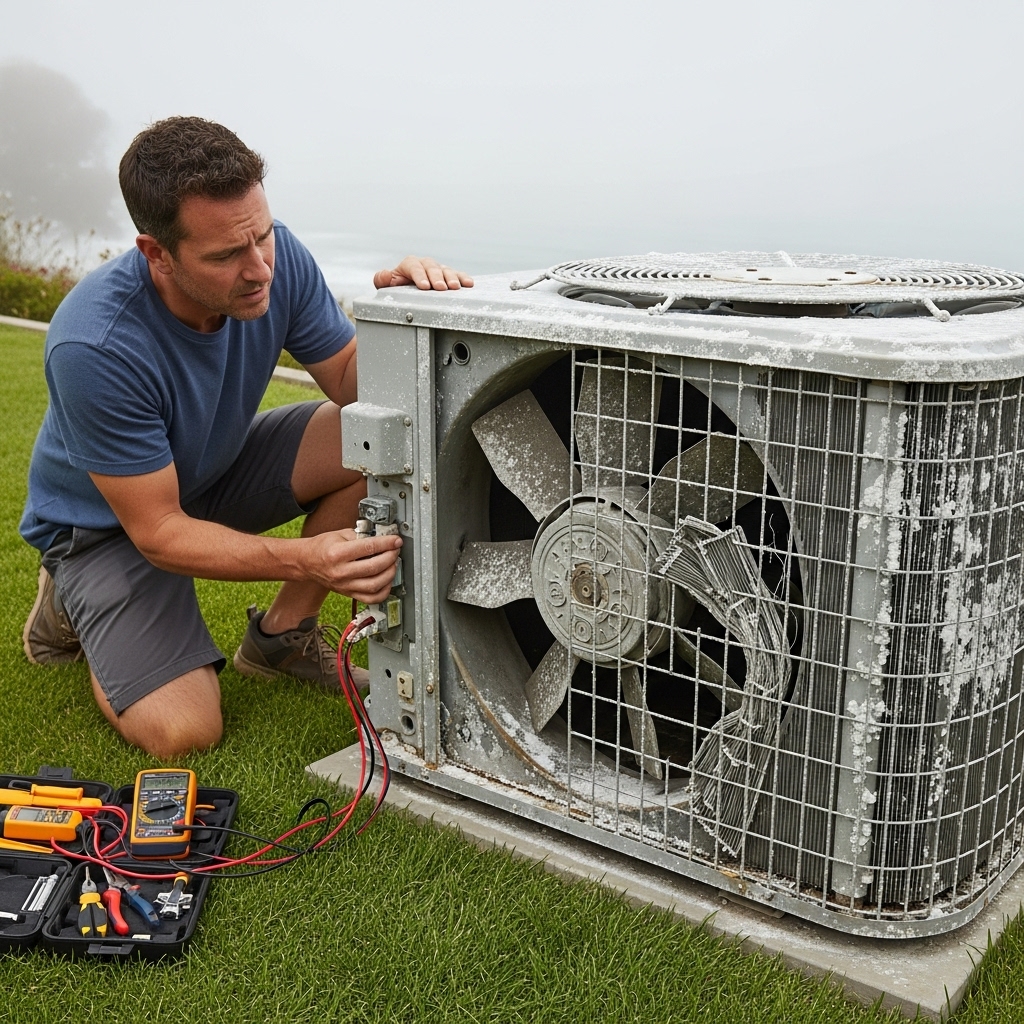When your Malibu home’s air conditioner isn’t performing, the fastest way back to comfort is a methodical troubleshooting approach tailored to coastal conditions. Salt air, sea fog, Santa Ana winds, and occasional wildfire smoke can create symptoms that look like equipment failure but are actually maintenance issues. This guide walks you through safe, homeowner-friendly checks and explains when to call a professional, so you can restore cool, dependable operation. For an organized maintenance framework to complement troubleshooting, see the reference at keyword and keep it handy for seasonal checkups.
Safety First
Before you begin, set priorities for safety. If you smell burning, see smoke from equipment, notice tripped breakers that won’t reset, or observe water near electrical parts, stop immediately and call a qualified technician. Turn off power at the thermostat and at the disconnect for outdoor work. Never remove panels you aren’t comfortable handling, and do not attempt refrigerant adjustments without proper licensing and tools.
Symptom: AC Won’t Turn On
If your system is silent and the indoor blower doesn’t start, run through these checks.
- Thermostat settings: Confirm cooling mode is selected, the setpoint is below room temperature, and schedule overrides aren’t preventing operation. If battery-powered, replace batteries.
- Breaker and disconnect: Verify the AC breaker is on and the outdoor disconnect is fully seated. Malibu’s wind can occasionally nudge covers or components out of position.
- Float switch and drains: A clogged condensate drain can trigger a safety float switch that stops cooling to prevent water damage. Inspect for water at the air handler and clear obvious blockages.
- Air filter: A severely clogged filter may cause the system to protect itself by limiting operation. Replace the filter and try again.
Symptom: Air Blows, But Not Cold
When the blower runs but the air feels warm or only slightly cool, focus on airflow and heat exchange.
- Outdoor unit operation: Check whether the outdoor fan is spinning. If it’s off while the indoor blower runs, the system can’t reject heat. Do not continue running the blower indefinitely, or you may worsen humidity.
- Condenser cleanliness: Salt and grime on the coil reduce heat rejection. Power off and rinse gently from the top down, avoiding strong pressure that can bend fins.
- Evaporator coil airflow: A clogged filter or iced coil restricts airflow. Replace the filter and look for frost on refrigerant lines near the air handler. If icing is present, shut the system off to thaw and call a pro if it recurs.
- Duct issues: Disconnected or crushed ducts, especially in attics, can divert cool air into unconditioned spaces. Visually inspect accessible sections for obvious defects.
Symptom: Weak Airflow from Vents
Low airflow feels like the system is straining. Address restrictions and mechanical issues first.
- Filters and returns: Replace clogged filters and clear furniture or drapes from return grilles.
- Supply registers: Make sure registers are open and not blocked by rugs or furnishings.
- Blower wheel dust: Accumulated dust can reduce airflow significantly. If you suspect a dirty blower, schedule professional cleaning.
- Duct leaks: Listen for air hissing in the attic and look for insulation darkening around joints, which often indicates leaks.
Symptom: Short Cycling
Short cycling—frequent on-and-off operation—stresses components and hurts comfort. Malibu’s temperature swings can reveal issues that are easy to miss in milder weather.
- Dirty filters or coils: Restrictions can cause overheating or icing that trips safety controls.
- Thermostat placement: Sunlit walls or proximity to kitchen appliances can mislead the thermostat. Shield from direct sun and avoid heat sources.
- Electrical components: Faulty capacitors or contactors can interrupt normal cycles. A professional can test and replace these parts safely.
Symptom: Water Near the Air Handler
Water suggests condensate management problems. Address quickly to prevent ceiling stains or damage, especially if your air handler is in the attic.
- Clogged drain: Clear algae or debris in the primary drain line. Look for a secondary drain discharge and check for flow.
- Float switch trips: Reset after clearing the drain, but if it trips again soon, have a technician evaluate for recurring buildup or improper slope.
- Dirty coil: A dirty evaporator coil can create uneven condensation that overwhelms the pan. Professional cleaning restores proper drainage.
Symptom: Strange Noises
New or worsening sounds are an early warning system.
- Rattles and vibrations: Tighten accessible cabinet screws, ensure the condenser is level, and check that pipes aren’t rattling against framing.
- Squeals or grinding: Blower or fan motor bearings may be failing. Shut down and call a professional to prevent further damage.
- Buzzing or clicking: Electrical components like contactors and relays can buzz under stress. Leave diagnosis to a trained technician.
Symptom: High Humidity or “Sticky” Comfort
Even when temperatures look fine, humidity can make rooms feel muggy. Coastal moisture, fog, and long cooling cycles can complicate dehumidification.
- Low fan speed settings: Slower airflow across the coil can improve moisture removal. A professional can confirm correct settings for your duct design.
- Oversized systems: Large systems may cool quickly but remove less moisture. Staging or control adjustments can help; consult a pro.
- Continuous fan mode: Running the fan constantly can re-evaporate moisture from the coil. Try auto mode during humid periods.
Mid-Season Performance Reset
When performance declines mid-summer, do a quick reset of basics: replace the filter, rinse the outdoor coil, inspect drains, and review thermostat settings. Document results so you can track patterns across seasons. If you want a single resource to verify you’ve covered the essentials without overspending time on low-value tasks, the overview at keyword is a helpful companion to this troubleshooting workflow.
Preventive Measures for Malibu Homes
Prevention reduces the need for emergency troubleshooting. Malibu’s marine environment suggests a few specific habits.
- Quarterly coil rinses: Gentle rinsing addresses salt deposition and windblown dust.
- Wind event checks: After Santa Ana winds, remove debris from the condenser and verify the fan spins freely.
- Smoke-season filter stock: Keep spares to avoid running the system with clogged media during poor air quality days.
- Duct inspection: Visually check accessible ductwork each season for leaks or crushed sections that erode performance.
When Troubleshooting Isn’t Enough
Some problems require tools and training you won’t have at home. Refrigerant leaks, electrical failures, control board issues, and blower motor failures need professional diagnosis. If your system repeatedly ices up, trips breakers, or leaks water despite drain cleaning, call for service. Clear notes about what you’ve tried will help the technician diagnose faster and more accurately.
Frequently Asked Questions
Why does my AC struggle more near the beach? Salt and moisture can coat the condenser coil and accelerate corrosion, reducing heat rejection. Regular gentle rinsing and corrosion checks help maintain performance.
What’s the fastest DIY fix when cooling drops suddenly? Change the filter, rinse the outdoor coil with power off, and verify the thermostat setpoint and mode. These steps solve many sudden declines.
How long should I wait after icing before restarting? Allow several hours for a full thaw with the system off. Replace the filter and run fan-only for a short period to dry the coil if recommended by your technician.
Is it okay to shade the outdoor unit? Yes—provided airflow is free on all sides. Avoid dense shrubs or covers that trap heat or moisture.
Why is one room always warmer? Duct balance, insulation levels, window exposure, and register placement matter. A professional can test static pressure and balance airflow to improve evenness.
Can thermostat placement really cause short cycling? Absolutely. Direct sun, proximity to ovens, or drafts can send false signals that shorten cycles. Relocation or shading may solve the problem.
Stay Ahead of Problems
Troubleshooting is easier when you keep a simple maintenance log and respond quickly to new sounds, smells, or performance changes. Malibu’s beauty brings unique AC challenges, but consistent attention to airflow, cleanliness, and drainage solves most issues before they interrupt your day.
Confident Cooling Starts Here
Restore comfort with calm, step-by-step troubleshooting and smart preventive care. If you’d like a concise framework to pair with these checks and to organize your seasonal conditioning plan, take a look at keyword. With the right habits and timely professional support, your Malibu home will stay cool, efficient, and comfortable through heat waves and marine layer mornings alike.

